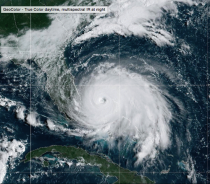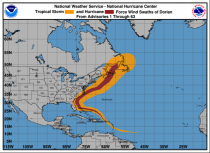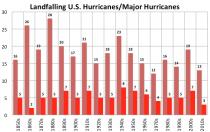![]()

Hudson Litchfield News September 20, 2019
Joseph D’Aleo, CCM , AMS Fellow
WEATHER
Dorian was a classic hurricane.

It’s hurricane winds savaged the northernmost Bahamas as a CAT5 storm but then as a weakening hurricane skimmed the southeast coast, southeast New England until pounding the Canadian Maritimes, often the graveyard for tropical and winter storms.

Nothing is new in weather. Great Colonial hurricanes in the northeast with storm surges up to 20 feet occurred in 1635 and 1675. In the Caribbean, the Great Hurricane of 1780 killed an estimated 27,500 people while ravaging the islands of the eastern Caribbean with sustained winds estimated to top 200 mph. It was one of three hurricanes that year with death tolls greater than 1000.
The late 1880s and 1890s were very active. 1893 had at least 10 hurricanes. Of those, 5 became major hurricanes. Two of the hurricanes caused over two thousand (2000) deaths in the United States; at the time, the season was the deadliest in U.S. history. The great Galveston hurricane in 1900 killed as many as 12,000 people as its storm surge flooded the island.
Hurricanes recurve north as soon as the opportunity presents itself. Like the ocean currents and non tropical storms, these storms help move heat north from the tropics where there is a net surplus of heat to northern latitudes where there are deficits. It this exchange did not happen, the northern areas would continue to get colder, tropical regions warmer. Sometimes the storms stall or loop if a blocking high pressure prevents their escape north. Often this happens over the open ocean. In Dorian’s case, sadly the stall occurred over the Grand Bahama and Great Abako islands with catastrophic results.
It was the 10th strongest Atlantic storm since 1900. The strongest, also a Labor Day storm, hit the Florida Keys in 1935.
Hurricane and major hurricane landfall trends have been down since the late 1800s. We had a record stretch of almost 12 years without a major landfalling hurricane before Harvey and Irma in 2017 and last year Michael. Dorian made first U.S. landfall in North Carolina but was no longer a major storm.

We have passed the peak of the hurricane season (September 10) and chances of a major landfall is declining quickly. If no further hurricane or major hurricane makes landfall, this decade would be the second quietest decade for hurricanes (behind 1970s) and second quietest for major hurricanes (behind the 1860s).
Should we worry here in New England? Yes, we should increase the awareness of the real threats and ways to protect your home and family.
Thanks to Hudson Cable TV, we have been given the chance to produce a series on the great hurricanes of the past called “Preparing for the Inevitable” with Joe Bastardi, his dad Matt and son Garrett, meteorologist Herb Stevens and storm chasing meteorologist Ron Moore (who last week was in Dorian’s outer bands).
We are very concerned about the inevitable return of a storm like the CAT3 Hurricane of ‘38, which fell 2 billion trees in the northeast as it traveled at 47 mph on a southeast to northwest path through New England. Matt Bastardi was in that hurricane as a boy in Providence, RI. He and I were both survived Hurricane Carol in 1954. Parts I and II were meteorological reviews of the great storms, Part III with FLASH’s Leslie Chapman-Henderson provided recommendations about how you should prepare here for the eventual return of a big one that could damage your home and keep us in the dark for many weeks even as winter comes on. Part IV has been added where we discuss and show how we can prepare for a storm like that. They also apply to the ice storms we get that can bring down trees and put us in the dark for many days. The shows cycle on cable but can be found here anytime.
SHOW 1 here.
SHOW 2: here
SHOW 3: here
Show 4: here
CLIMATE
Do we have an existential threat due to climate change as the seven hour CNN climate change scareathon and the candidates now barnstorming the state are claiming. The answer is an absolute NO. In the 1970s we were told because of population growth, climate stress (then cold), insufficient energy and crop failures within a decade, 100,000s of millions would die, tens of millions in the U.S. and it was too late to stop. Even as each dire forecast failed, the scares continued, with the date just push forward - 2000, 2020, and now 2030. BTW, they quietly removed snow and ice covered signs at Glacier National Park this season that said, “Warning: glaciers will be gone by 2020.”
We put together a team of scientific experts and looked at the 12 most commonly reported claims and found them all unfounded see .
Instead, as energy production increased and prosperity improved, global extreme weather related losses as a function of GDP declined 50% the last 3 decades and here in the U.S., there was a 98% decline in extreme weather deaths in the 20th century.
In the U.S., with low cost energy, lowered taxes and reduced unnecessary regulations, we now have the lowest unemployment for the nation, for blacks, hispanics, women, young people in decades or history and for the first time in a long time significant wage increases! Here in NH, we have the lowest unemployment in the nation. The U.S. is energy independent, a long time thought unachievable goal. Our air and water is cleanest in our lifetimes well below the tough standards we out in places decades ago.
The real existential threat comes would come from radical environmentalism and the prescribed remedies. The scare is not based on fact but is politically driven, all about big government and control over every aspect of your life. They assume as Jonathan Gruber of MIT, an Obama advisor of health care, opined most people are ‘stupid’ and will believe what you say especially if the media provides an echo chamber. Rep. Alexandria Ocasio-Cortez’s chief of staff recently admitted that the Green New Deal was not conceived as an effort to deal with climate change, but instead a “how-do-you-change-the-entire economy thing"-- nothing more than a thinly veiled socialist takeover of the U.S. economy.
“The interesting thing about the Green New Deal is it wasn’t originally a climate thing at all, Saikat Chakrabarti said in May. He was echoing what the climate change head of the UN climate chief and the UN IPCC Lead Author said - that is was our best chance to change the economic system (to centralized control) and redistribute wealth (socialism).
The economy in every country that has moved down an extreme green path has been hurt. Renewables are unreliable as the wind doesn’t always blow and sun shine. And don’t believe the claims millions of green jobs would result. In Spain, every green job created cost Spain $774,000 in subsidies and resulted in a loss of 2.2 real jobs. Only 1 in 10 green jobs were permanent. Industry left and in Spain unemployment rose to 27.5%.
Many households in the countries that have gone green are said to be in “energy poverty” (25% UK, 15% Germany). Their energy costs are up to 3 times higher than the U.S. The elderly are said in winter to be forced to “choose between heating and eating” and there are life-threatening blackouts.

Extreme cold kills 20 times more than heat according to a study of 74 million deaths in 13 countries. A new report by consulting giant McKinsey finds that Germany’s energy transition to renewables, poses a significant threat to the nation’s economy and energy supply which one of Germany’s largest newspapers Die Welt, summarized in a single word: “disastrous.”
I was asked by the NH Taxpayers Association to address ”Real Facts about the Climate”. I review all the climate facts and the scary dangerous impacts of radical environmentalism and big government takeover of our energy system (and with ‘healthcare for all’, all aspects of our lives).
See more on the fallacy of the millions of green jobs as promised by the scheming socialist candidates here. The GND that would cost the average family over $10,000 more per year.
Also note:
Staggering energy prices are taking a toll on those unable to pay their bills, a UK regulator has admitted, confirming that thousands of people may have died because of fuel poverty and lack of heating during winter.
The most vulnerable households spend more on their energy bills than wealthier ones, and “can therefore be at greater risk of fuel poverty,” according to a comprehensive new study by the Office of Gas and Energy Markets (Ofgem) on Thursday.
Fuel poverty, a common UK term for customers who cannot afford to keep adequately warm at an affordable cost, “increases the risk that people [will] develop ill health,” it acknowledged.
Over winter 2017-18, we estimate that fuel poverty may have contributed to 5,500 excess winter deaths and that 16,500 excess winter deaths may have been linked to people living in cold homes.




